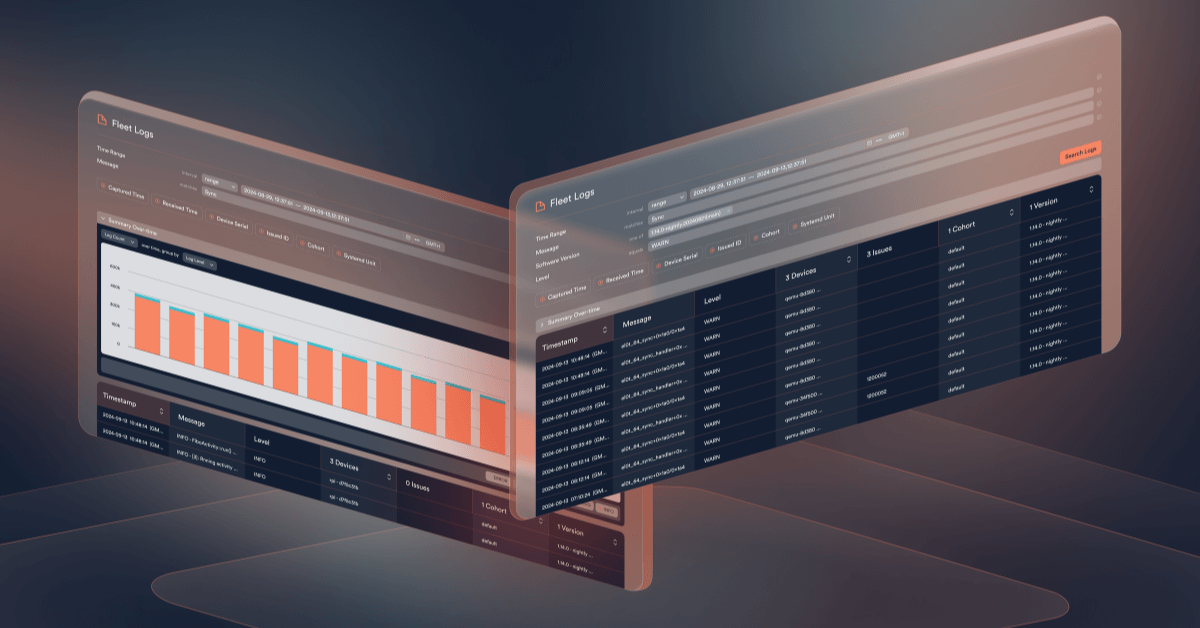Share
Last month, the most intense solar storm in decades hit Earth. These events are known to wreak havoc on satellites and communications systems—so it stands to reason they will impact the connected devices that rely on these technologies. I was curious: how did the May 2024 solar storm impact our customers’ smart devices? To find out, we examined data from a sample of over 10 million Internet of Things (IoT) devices monitored by Memfault.
Let’s dive into the data together and see what the findings can teach us.
What is a solar storm?
A solar storm is a disturbance in space weather caused by the Sun’s activity, particularly solar flares and coronal mass ejections (CMEs). These events release a massive amount of energy and charged particles into space, which can travel toward Earth and interact with its magnetic field.
For most people, the May 2024 solar storm was an opportunity to see the aurora for the first time. Indeed, we saw the strongest auroras in more than 500 years with sightings reported as far south as Florida.
How do solar storms impact smart devices?
Although solar storms are not harmful to humans, they can cause significant damage to electronics. Charged particles can lead to memory corruption, and rapidly fluctuating magnetic fields can induce current in wires which in extreme cases can destroy devices. Satellites and transformers are the most at risk, but IoT devices are not immune.
The May 2024 solar storm sent farmers scrambling when it knocked out the GPS equipment they rely on to cultivate their land and plan for future harvests.
This isn’t the first time so-called “cosmic rays” have been blamed for problems. A decade ago, NASA and the NHTSA even investigated them as a potential cause for unintended accelerations of Toyota vehicles that led to deadly collisions.
Experts predict that solar storms will happen more and more. So should we be concerned about the potential impact on our IoT devices? Let’s look to the data to decide.
Did the solar storm impact IoT devices at scale?
In case you’re not familiar with Memfault, we build observability solutions for embedded devices. Our customers are innovative IoT businesses that use our platform to quickly catch and fix defects before they affect too many of users. Today we monitor well over 10 million devices in mission-critical industries such as access control, point of sale, energy, and healthcare.
How did these devices react to the solar storm?
First, let’s figure out which days exactly had high solar flare activity. Using the handy calendar at SpaceWeatherLive, we see that April 19, May 2, May 10, May 11, and May 12 all had high K-indices.
Now that we know what days to look for, let’s take a look at how the devices Memfault monitors performed on those days.
Tracking performance issues and malfunctions
First, we pulled the total numbers of resets observed across the devices that were active on the days of high solar flare activity. Because all of our reset data is stored in a table in our high performance analytics cluster, we can quickly and easily answer these kinds of questions. I’d like to give a huge shout out to Avery Fischer for his help dissecting the data.
The chart below shows the results, with the high K-index days highlighted in red.
As we can see, the K-index does seem to correlate with higher numbers of resets! It’s important to note that this is not an overwhelming effect. If a device in your home or office reset on May 10th, it was likely due to a software bug or a firmware update. But about 1 in 5 resets may be attributable to the solar storm!
Total resets do not tell the whole picture. It could be that a few highly sensitive devices reset over and over again, but that most devices were unaffected. Let’s look at how many devices saw at least one reset in a given day across the fleet and see how that compares to an average day in that month.
Here again, we see a clear effect!
Over 25% more devices saw resets during high K-index days than on an average day each month, and the days with the highest indexes seem to have affected the most devices. This indicates that if there was an effect, it was not limited to a few devices, but rather was broadly distributed across the fleet.
While correlation is not causation, I am confident that the solar storm had something to do with some of those resets. In fact, April 19th and May 10th stand out as clear outliers when we look back at the last few years of data.
What can we do about it?
I often advise that if your device misbehaves, it is most likely a problem with the software, so check that first. Next, look at the hardware—but don’t blame outer space because it’s probably not the cause of your problems. Turns out that’s not entirely true: sometimes it really is cosmic rays!
The recent solar storms are a reminder of the numerous environmental factors beyond our control. As more people rely on smart devices for critical functions like healthcare and security, it’s even more important to implement precautions and standards. We must be able to quickly spot and fix issues, whether they’re caused by a software bug, a solar flare, or a cyber attacker. Capabilities like OTA updates and device monitoring can help us ensure our IoT products work as intended, no matter what Mother Nature throws our way.
Experts predict more solar storms through June, so we’ll be keeping an eye on the impacts.
I hope you enjoyed this dive through the data as much as I did! Only hardware changes such as using ECC memory can help us avoid errors induced from cosmic rays. For the much more common software bugs that are the cause of most resets, consider using Memfault to find and fix them!








